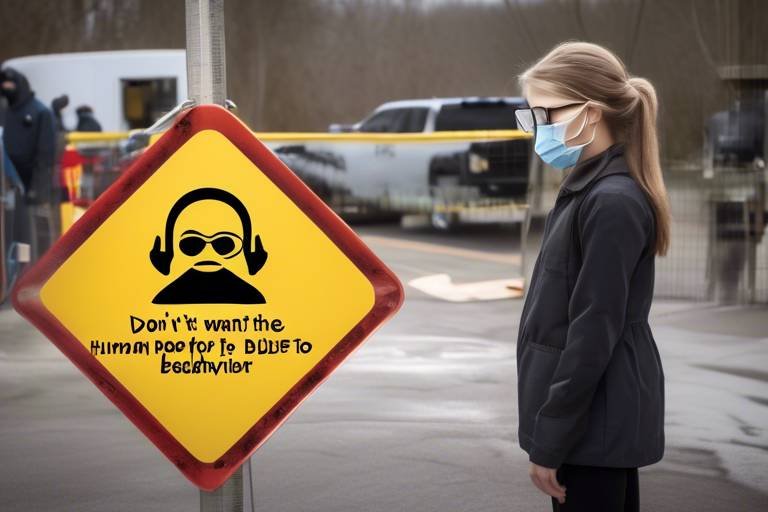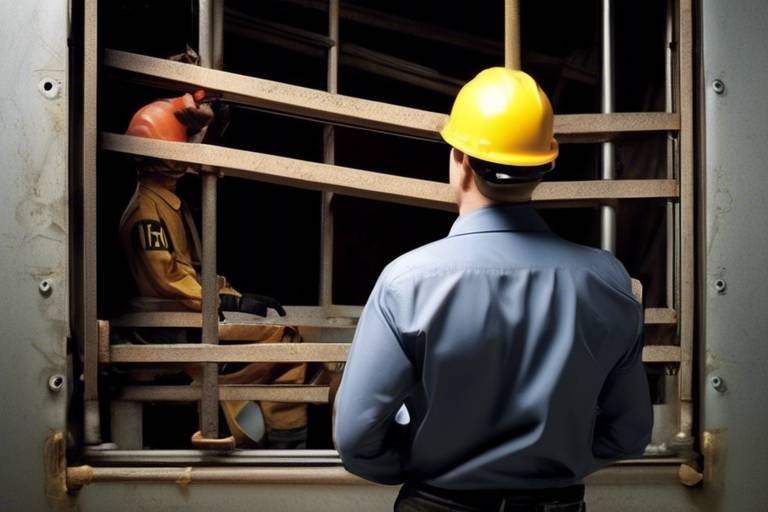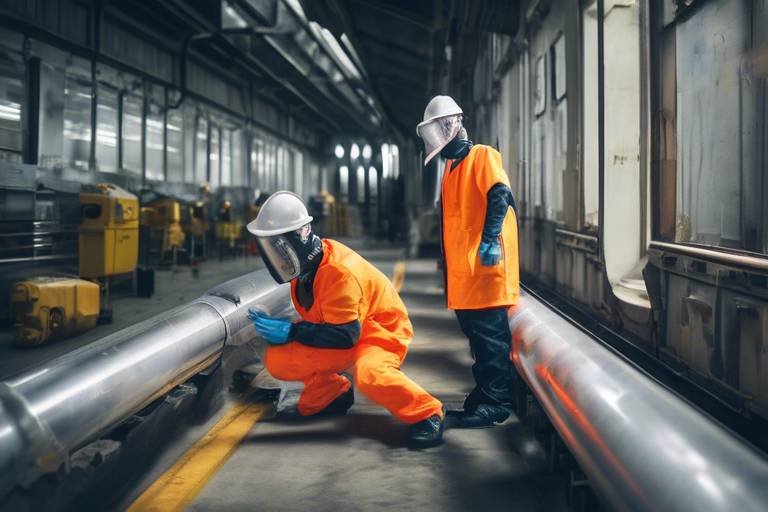The Guide to Understand Human Behavior for Safety Implementation
Understanding human behavior is not just an academic exercise; it's a crucial element in enhancing safety measures across various environments. When we think about safety, we often focus on protocols, equipment, and regulations. However, the real game-changer lies in how people perceive risks, make decisions, and react under pressure. By delving into the intricacies of human behavior, organizations can tailor their safety practices to better fit the realities of human psychology, ultimately leading to safer workplaces.
Imagine a construction site bustling with activity. Workers are equipped with hard hats, safety goggles, and harnesses. Yet, despite all these precautions, accidents still occur. Why? The answer often lies in the way individuals interpret their surroundings and respond to safety protocols. Understanding these behaviors can help organizations not only identify potential risks but also foster a culture where safety is prioritized and ingrained in the daily routines of employees.
Moreover, the importance of human behavior in safety implementation extends beyond merely following rules. It's about creating an environment where everyone feels responsible for safety, where communication flows freely, and where employees are encouraged to voice concerns without fear of retribution. This cultural shift can lead to significant improvements in safety outcomes, as individuals become more vigilant and proactive in identifying hazards.
In our exploration of this topic, we will uncover various psychological factors that influence safety behaviors, such as motivation, perception, and stress. We'll also delve into how cognitive biases can distort decision-making processes, leading individuals to overlook critical safety measures. By understanding these elements, organizations can develop effective strategies to counteract biases and enhance safety practices.
Ultimately, the goal is to create a safety culture that not only complies with regulations but also resonates deeply with the values and behaviors of the workforce. This involves the active participation of leadership in setting the tone and expectations for safety, as well as engaging employees in initiatives that promote accountability and ownership. Together, these efforts can lead to a transformative approach to safety that is both proactive and sustainable.
Understanding human behavior is crucial for implementing effective safety measures, as it helps identify potential risks and fosters a culture of safety within organizations.
Various psychological factors, such as perception, motivation, and stress, significantly impact how individuals respond to safety protocols and their overall behavior in hazardous situations.
Cognitive biases can distort decision-making processes, leading individuals to overlook safety protocols or underestimate risks, which can compromise safety in critical situations.
Recognizing common cognitive biases, such as overconfidence and confirmation bias, can help organizations develop strategies to mitigate their effects on safety behavior.
Implementing training programs and decision-making frameworks can effectively counteract cognitive biases, promoting safer behaviors among employees.
Behavioral economics provides insights into how economic factors influence safety behavior, helping organizations design incentives that encourage adherence to safety protocols.
Establishing a strong safety culture involves promoting open communication, accountability, and continuous improvement, which can significantly enhance safety outcomes in the workplace.
Effective leadership is vital in fostering a safety culture, as leaders set the tone and expectations for safety practices within their organizations.
Engaging employees in safety initiatives encourages ownership and accountability, leading to improved adherence to safety protocols and a more proactive approach to risk management.
- Why is understanding human behavior important for safety?
- Understanding human behavior allows organizations to identify risks and tailor safety measures that resonate with employees, leading to a more effective safety culture.
- What are cognitive biases?
- Cognitive biases are systematic patterns of deviation from norm or rationality in judgment, which can affect decision-making processes related to safety.
- How can organizations counteract cognitive biases?
- Organizations can counteract cognitive biases by implementing training programs that raise awareness and establish decision-making frameworks that promote rational thinking.
- What role does leadership play in safety culture?
- Leadership plays a crucial role in setting the tone for safety practices, influencing the organization's commitment to safety and encouraging employee engagement.

The Importance of Human Behavior in Safety
Understanding human behavior is crucial for implementing effective safety measures in any environment. Why? Because at the end of the day, safety protocols are only as effective as the people who follow them. If employees don’t understand the importance of these protocols or feel disengaged, the likelihood of accidents increases significantly. It’s like having a shiny new car but forgetting to put gas in it; without the right motivation and understanding, even the best safety practices can stall.
Moreover, when organizations prioritize understanding human behavior, they not only identify potential risks more effectively but also foster a culture of safety that permeates every level of the organization. This culture is built on trust, communication, and a shared commitment to safety. For instance, when employees feel that their concerns about safety are heard and addressed, they are more likely to adhere to safety protocols and even report unsafe conditions. It’s a win-win situation!
To illustrate this, consider the following table that outlines the key elements of human behavior that influence safety practices:
| Element | Description |
|---|---|
| Awareness | The ability to recognize hazards and understand safety procedures. |
| Motivation | Incentives that drive individuals to follow safety protocols. |
| Communication | Open channels for discussing safety concerns and protocols. |
| Accountability | Responsibility for adhering to and promoting safety measures. |
In addition, it’s essential to recognize that human behavior is not static; it evolves over time. As new technologies and processes are introduced, employees may need guidance to adapt their behaviors accordingly. This is where training and continuous education come into play. By regularly updating training programs and reinforcing the importance of safety, organizations can ensure that employees remain vigilant and engaged.
Ultimately, understanding human behavior in the context of safety is about fostering a mindset that prioritizes safety above all else. It’s about creating an environment where employees feel empowered to speak up about safety issues and where they understand that their actions have a direct impact on their safety and the safety of their colleagues. So, how can organizations cultivate this mindset? It starts with leadership setting a clear example and demonstrating a genuine commitment to safety practices.
In conclusion, human behavior is at the heart of effective safety implementation. By understanding the psychological and social factors that influence behavior, organizations can create a robust safety culture that not only minimizes risks but also enhances overall workplace morale. After all, when employees feel safe and valued, they are more likely to contribute positively to the organization’s success.
- Why is human behavior important in safety? Human behavior directly influences how safety protocols are followed and how risks are managed in the workplace.
- What role does leadership play in safety culture? Leadership sets the tone for safety practices and promotes an environment where safety is prioritized.
- How can organizations improve employee engagement in safety initiatives? By involving employees in safety discussions and decision-making processes, organizations can foster a sense of ownership and accountability.

Psychological Factors Influencing Safety
When it comes to safety, understanding the psychological factors that influence human behavior is paramount. These factors can shape how individuals perceive risks, respond to safety protocols, and engage in hazardous situations. For instance, the way people perceive their environment can drastically alter their behavior. If an employee feels that a workplace is safe, they may become complacent, overlooking potential hazards. On the flip side, if they perceive a high level of risk, it can lead to anxiety and hesitation, which may also compromise their ability to act swiftly in emergencies.
Moreover, motivation plays a crucial role in safety practices. Employees who are motivated to follow safety protocols are more likely to do so. This motivation can stem from various sources, including personal values, peer pressure, or organizational culture. If safety is prioritized and rewarded within a company, you can bet that employees will be more inclined to adhere to those practices. However, if safety measures are seen as mere formalities, employees might not take them seriously, which can lead to dangerous situations.
Stress is another psychological factor that can significantly impact safety behavior. Under high stress, individuals may struggle to focus on safety protocols or make sound decisions. For example, during a high-pressure situation, someone might forget to wear their safety gear or skip essential safety checks. This highlights the need for organizations to not only implement safety measures but also to create an environment that minimizes stress and promotes mental well-being.
In addition to these factors, cognitive biases can distort how individuals perceive risks and make decisions regarding safety. For instance, someone might fall victim to overconfidence bias, believing they can handle a situation without following established safety protocols. This can lead to risky behaviors that compromise not only their safety but also that of their colleagues. Similarly, confirmation bias can cause individuals to seek out information that supports their preconceived notions about safety, ignoring evidence that contradicts their beliefs. Understanding these biases is crucial for organizations aiming to enhance safety practices.
To further illustrate these psychological factors, consider the following table that summarizes key influences on safety behavior:
| Psychological Factor | Impact on Safety |
|---|---|
| Perception | Affects risk assessment and behavior in hazardous situations. |
| Motivation | Drives adherence to safety protocols. |
| Stress | Can impair decision-making and focus on safety measures. |
| Cognitive Biases | Distorts risk perception and decision-making. |
By recognizing and addressing these psychological factors, organizations can create a more effective safety culture. This involves not just implementing rules, but also fostering an environment where employees feel valued, understood, and empowered to prioritize safety. After all, a safe workplace is not merely about following protocols; it’s about cultivating a mindset that values safety at every level.

Cognitive Biases and Decision Making
When it comes to safety, the way we make decisions can be heavily influenced by cognitive biases. These biases are mental shortcuts that our brains take, often leading us to make irrational choices without even realizing it. For instance, have you ever thought you were invincible while driving, only to find yourself in a close call? That’s overconfidence bias at work! It’s a classic example of how our perception can distort reality and compromise our safety.
Cognitive biases can manifest in various ways, and understanding them is crucial for improving safety practices. One common bias is the confirmation bias, where individuals tend to seek out information that supports their existing beliefs while ignoring contradictory evidence. In a safety context, this could mean overlooking safety protocols because one believes they are already safe, leading to risky behaviors. Imagine a worker who has completed a task thousands of times; they might skip safety checks, convinced they know better. This mindset can create a dangerous environment, not just for themselves but for their colleagues as well.
To effectively address these biases, organizations need to implement strategies that promote awareness and critical thinking among employees. For example, conducting regular training sessions that highlight these biases can help individuals recognize their own thought patterns. Here’s a simple table that outlines some common cognitive biases and their implications for safety decision-making:
| Cognitive Bias | Description | Safety Implication |
|---|---|---|
| Overconfidence Bias | The tendency to overestimate one’s abilities. | Leads to risky behavior, such as skipping safety measures. |
| Confirmation Bias | Favoring information that confirms existing beliefs. | Results in ignoring safety warnings or protocols. |
| Anchoring Bias | Relying too heavily on the first piece of information encountered. | Can result in misjudging risks based on initial impressions. |
By understanding these biases, organizations can develop training programs that not only educate employees about risks but also encourage them to adopt a more analytical approach to decision-making. For instance, incorporating real-life scenarios and role-playing exercises into safety training can help individuals practice recognizing and countering their biases in a controlled environment. This hands-on approach can be much more effective than traditional lecture-based training, as it allows employees to engage actively with the material.
Additionally, creating an environment that encourages open communication can significantly mitigate the effects of cognitive biases. When employees feel safe to voice their concerns or share their experiences, it fosters a culture of safety where everyone is more likely to adhere to protocols. This collaborative approach not only enhances individual decision-making but also strengthens the organization’s overall safety framework.
In conclusion, cognitive biases play a significant role in how individuals make decisions regarding safety. By recognizing these biases and implementing targeted strategies to counteract them, organizations can create a safer work environment. It’s all about shifting the mindset from a reactive approach to a proactive one, where safety becomes a shared responsibility and a core value within the organization.
- What are cognitive biases? Cognitive biases are systematic patterns of deviation from norm or rationality in judgment, which often lead to illogical conclusions.
- How do cognitive biases affect safety? They can distort perception and decision-making, leading individuals to underestimate risks or overlook safety protocols.
- What can organizations do to mitigate cognitive biases? Implement training programs, promote open communication, and encourage analytical thinking to help employees recognize and counteract biases.

Common Cognitive Biases
Cognitive biases are like those sneaky little gremlins in our minds that can distort our perception of reality, especially when it comes to safety. They can lead us to make decisions that might not be in our best interest, particularly in high-stakes environments. For instance, one of the most prevalent biases is overconfidence bias. This is where individuals believe they are less likely to experience negative outcomes compared to others. Imagine a driver who thinks they can text while driving because they’ve never had an accident; this overconfidence can lead to catastrophic results.
Another common bias is confirmation bias. This occurs when people favor information that confirms their pre-existing beliefs. For example, if someone believes that a certain safety protocol is unnecessary, they might only pay attention to information that supports this view, ignoring evidence to the contrary. This can be particularly dangerous in workplaces where adherence to safety measures is critical.
Moreover, anchoring bias can play a significant role in decision-making. This happens when individuals rely too heavily on the first piece of information they receive. In safety contexts, if a worker is initially told that a machine is safe to operate, they might disregard subsequent warnings or updates that indicate otherwise. It’s as if that initial piece of information has anchored their perception, making it hard for them to adjust their views even when new evidence arises.
To illustrate the impact of these biases, consider the following table that summarizes some common cognitive biases and their effects on safety behavior:
| Cognitive Bias | Description | Impact on Safety |
|---|---|---|
| Overconfidence Bias | Belief in one's abilities or safety measures | Underestimating risks, leading to unsafe behaviors |
| Confirmation Bias | Favoring information that supports existing beliefs | Ignoring safety protocols that contradict personal views |
| Anchoring Bias | Relying heavily on the first piece of information | Disregarding new safety information or updates |
Recognizing these cognitive biases is the first step toward mitigating their effects. By understanding how they operate, organizations can create strategies to counteract these biases. For instance, implementing regular training sessions that emphasize the importance of safety protocols can help employees overcome overconfidence. Additionally, fostering an environment where questioning and discussing safety measures is encouraged can combat confirmation bias. Ultimately, by addressing these cognitive biases head-on, we can cultivate a safer work environment for everyone.
- What are cognitive biases? Cognitive biases are systematic patterns of deviation from norm or rationality in judgment, which can affect decision-making.
- How do cognitive biases impact safety? They can lead individuals to underestimate risks or overlook critical safety protocols, increasing the likelihood of accidents.
- Can training help mitigate cognitive biases? Yes, regular training and awareness programs can help employees recognize and counteract their biases, promoting safer behaviors.

Strategies to Counteract Biases
In the complex landscape of safety implementation, understanding and counteracting cognitive biases is crucial for fostering a safer environment. These biases can lead individuals to make decisions that overlook safety protocols, often with dire consequences. So, how can organizations effectively combat these biases and promote safer behaviors? Here are some proven strategies that can make a significant difference.
First and foremost, training programs should be developed to educate employees about cognitive biases and their potential impact on safety. By raising awareness, individuals can learn to recognize when these biases come into play. Imagine you’re driving a car; if you know that fatigue can impair your judgment, you’re more likely to take a break before continuing your journey. Similarly, training can empower employees to pause and reflect on their decisions when they might be influenced by bias.
Another effective strategy is to implement decision-making frameworks that encourage thorough evaluation of risks. These frameworks can serve as checklists, guiding employees through a systematic process to assess safety considerations before making decisions. For instance, a simple table could be used to evaluate potential hazards against established safety protocols, prompting employees to think critically about their choices.
| Potential Hazard | Safety Protocol | Action Required |
|---|---|---|
| Slippery Floors | Use of Non-Slip Mats | Inspect and Place Mats |
| Heavy Lifting | Team Lifting Procedures | Review and Apply Procedures |
Additionally, organizations can foster a culture of open communication where employees feel comfortable discussing safety concerns without fear of judgment. This can be achieved through regular safety meetings and feedback sessions. When employees know they can voice their concerns, they are more likely to report unsafe conditions and behaviors, which can lead to collective improvements in safety practices.
Moreover, implementing peer accountability systems can also help counteract biases. When employees are encouraged to look out for one another, it creates a sense of ownership and responsibility. Just like a team of lifeguards watching over a pool, having colleagues hold each other accountable can significantly enhance adherence to safety protocols.
Lastly, utilizing incentives for safe behavior can effectively motivate employees to prioritize safety. Recognizing and rewarding individuals or teams for their commitment to safety practices can reinforce positive behaviors. It’s similar to how athletes train harder when they know there’s a medal at stake; the allure of recognition can drive individuals to overcome biases and adhere to safety protocols.
In conclusion, by implementing comprehensive training programs, decision-making frameworks, fostering open communication, encouraging peer accountability, and providing incentives, organizations can effectively counteract cognitive biases. These strategies not only enhance safety measures but also cultivate a culture where safety is a shared responsibility, ultimately leading to a safer workplace for everyone.
- What are cognitive biases? Cognitive biases are systematic patterns of deviation from norm or rationality in judgment, which can affect how individuals make decisions, especially in safety-critical situations.
- How can training programs help? Training programs help employees recognize and understand cognitive biases, equipping them with the knowledge to make safer decisions.
- What role does communication play in safety? Open communication fosters a culture of safety where employees feel comfortable reporting hazards and discussing safety concerns.
- How can incentives improve safety behavior? Incentives motivate employees to adhere to safety protocols by recognizing and rewarding their commitment to safe practices.

Behavioral Economics in Safety Practices
Behavioral economics delves into the intricate ways in which economic factors shape our decisions and behaviors, especially in the context of safety practices. It combines insights from psychology and economics to understand how people actually make choices, rather than how they should make them according to traditional economic theories. This approach is particularly relevant in safety management, where understanding the motivations behind individuals' actions can lead to more effective safety protocols and initiatives.
One of the key principles of behavioral economics is that people often act irrationally, influenced by cognitive biases and emotional responses. For instance, an employee might underestimate the risks associated with a task simply because they have completed it successfully in the past. This is where behavioral economics shines, as it allows organizations to design safety measures that account for these human tendencies. By identifying the economic incentives that drive behavior, companies can create strategies that encourage safer practices.
Consider the implementation of incentive programs as a practical application of behavioral economics in safety practices. These programs can be structured to reward employees for adhering to safety protocols. For example, a company might offer bonuses or recognition for teams that maintain a record of zero accidents over a specified period. This not only motivates employees to follow safety rules but also fosters a sense of community and shared responsibility towards safety. The table below illustrates various incentive strategies that can be employed:
| Incentive Type | Description | Expected Outcome |
|---|---|---|
| Monetary Bonuses | Financial rewards for teams achieving safety milestones | Increased motivation and adherence to safety protocols |
| Recognition Programs | Acknowledgment of individuals or teams for exemplary safety practices | Enhanced morale and commitment to safety |
| Training Opportunities | Providing additional training for teams that show improvement | Improved skills and knowledge related to safety |
Moreover, behavioral economics emphasizes the importance of framing and context in decision-making. How safety information is presented can significantly influence behavior. For example, if safety guidelines are framed as mandatory rules, employees might view them as burdensome. However, if these guidelines are framed as essential for their well-being and the well-being of their colleagues, employees may respond more positively. This shift in perspective is crucial for cultivating a safety-first mindset.
Another aspect to consider is the impact of social norms on safety behavior. People often look to their peers when deciding how to act. If an organization promotes a culture where safety is prioritized and visibly practiced by leadership and colleagues, employees are more likely to adopt similar behaviors. This peer influence can be harnessed through team-based safety challenges or collaborative safety audits, where teams work together to identify potential hazards and propose solutions. Such initiatives not only improve safety but also build camaraderie among employees.
In summary, integrating behavioral economics into safety practices is about understanding the human element in decision-making. By recognizing the psychological and economic factors that influence behavior, organizations can create more effective safety programs that resonate with employees. This approach not only enhances compliance with safety protocols but also fosters a culture of safety that permeates throughout the organization.
- What is behavioral economics? Behavioral economics is the study of how psychological factors affect economic decision-making, particularly how people make choices in real-world scenarios.
- How can behavioral economics improve safety practices? By understanding the motivations and biases that influence behavior, organizations can design safety measures that encourage compliance and enhance overall safety culture.
- What are some examples of incentives for promoting safety? Incentives can include monetary bonuses, recognition programs, and additional training opportunities for teams that demonstrate safe practices.
- Why is framing important in safety communication? The way safety information is presented can significantly impact how it is perceived and acted upon by employees, making effective framing essential for promoting safety.

Creating a Safety Culture
Establishing a robust safety culture is akin to nurturing a thriving garden; it requires attention, care, and a proactive approach. A safety culture is more than just a set of rules; it’s an entire mindset that permeates every level of an organization. When employees feel that safety is a priority, they are more likely to adopt safe practices and report hazardous conditions. This leads to a significant reduction in workplace incidents, ensuring not just compliance, but a genuine commitment to safety.
One of the essential components of creating this culture is open communication. Employees should feel empowered to voice their concerns without fear of reprisal. When individuals can freely discuss safety issues, it fosters a sense of community and shared responsibility. For instance, regular safety meetings can be an excellent platform for employees to share their experiences and suggest improvements. These meetings can be structured to include:
- Sharing of near-miss incidents
- Discussion of safety protocols
- Recognition of safe behaviors
Another critical aspect is accountability. Every member of the organization, from the top management to the newest hire, should understand their role in maintaining safety standards. This can be achieved through clearly defined responsibilities and regular performance evaluations that include safety metrics. When everyone knows they are accountable for safety, it creates a collective effort towards achieving a safer workplace.
Moreover, a culture of continuous improvement is vital. Safety practices should not be static; they need to evolve based on feedback and changing circumstances. This can involve regular training sessions that keep safety protocols fresh in employees’ minds, as well as audits and assessments that identify areas for improvement. By implementing a feedback loop where employees can suggest changes based on their experiences, organizations can ensure that their safety measures remain relevant and effective.
Leadership plays a pivotal role in embedding safety into the organizational culture. Leaders must not only communicate the importance of safety but also model safe behaviors themselves. When leaders prioritize safety, it sends a powerful message to employees that safety is a core value of the organization. This can be further reinforced by incorporating safety metrics into leadership performance reviews, ensuring that leaders are held accountable for fostering a safe environment.
Finally, employee engagement is crucial. When employees are actively involved in safety initiatives, they are more likely to take ownership of their safety and the safety of their colleagues. This can be achieved through various means, such as:
- Involving employees in safety committees
- Encouraging participation in safety training
- Soliciting feedback on safety protocols
In conclusion, creating a safety culture is an ongoing journey that requires commitment from everyone in the organization. By fostering open communication, accountability, continuous improvement, strong leadership, and employee engagement, organizations can cultivate a culture where safety is a shared responsibility. This not only enhances safety outcomes but also contributes to a more productive and positive work environment.
Q1: What is a safety culture?
A safety culture refers to the shared values, beliefs, and practices regarding safety within an organization. It emphasizes the importance of safety as a core value and encourages all employees to prioritize safe practices.
Q2: How can leadership influence safety culture?
Leadership sets the tone for safety culture by modeling safe behaviors, communicating the importance of safety, and holding themselves and others accountable for safety practices.
Q3: Why is employee engagement important in safety initiatives?
Engaging employees in safety initiatives fosters a sense of ownership and accountability, leading to improved adherence to safety protocols and a proactive approach to risk management.
Q4: What role does communication play in safety culture?
Open communication allows employees to voice concerns and share experiences, which fosters a sense of community and encourages collective responsibility for safety.

Leadership's Role in Safety Culture
When it comes to establishing a robust safety culture, the role of leadership cannot be overstated. Leaders are not just figureheads; they are the *heartbeat* of an organization’s safety practices. They set the tone for how safety is perceived and prioritized within the workplace. Think of a ship's captain navigating through stormy seas—without a steady hand at the helm, the ship risks capsizing. Similarly, effective leaders steer their teams toward safer practices, ensuring that everyone understands the importance of safety protocols.
One of the key responsibilities of leaders is to create an environment where safety is valued. This means going beyond mere compliance with regulations; it involves fostering a culture where safety is integrated into every aspect of operations. Leaders must communicate the *why* behind safety measures, helping employees see that these protocols are not just rules to follow but essential practices that safeguard their well-being. When employees understand the rationale behind safety initiatives, they are more likely to embrace them wholeheartedly.
Moreover, leaders must lead by example. If a manager skips safety protocols or shows indifference toward safety measures, employees are likely to mirror that behavior. This concept is often referred to as the *“trickle-down effect.”* When leaders actively participate in safety training and adhere to protocols, they signal to their teams that safety is a shared responsibility. It’s about showing that safety is not just a checkbox on a to-do list but a fundamental value of the organization.
Engagement is another crucial aspect of leadership in safety culture. Leaders should actively involve employees in safety discussions and initiatives, making them feel like vital contributors to the safety landscape. This can be achieved through regular safety meetings, feedback sessions, and by encouraging employees to voice their concerns and suggestions. By creating an open line of communication, leaders empower employees to take ownership of safety, fostering a sense of accountability that can significantly enhance adherence to safety protocols.
In addition to fostering communication, leaders should also focus on continuous improvement. Safety is not a one-time effort; it requires ongoing evaluation and adaptation. Leaders must regularly assess safety practices, identify areas for improvement, and implement necessary changes. This could involve conducting safety audits, analyzing incident reports, or soliciting employee feedback. By demonstrating a commitment to continuous improvement, leaders reinforce the idea that safety is a dynamic process, not a static goal.
To summarize, effective leadership plays a pivotal role in shaping a strong safety culture. By setting a positive example, fostering open communication, and committing to continuous improvement, leaders can create an environment where safety is prioritized and valued. Remember, a strong safety culture doesn’t just happen; it is cultivated through intentional actions and a shared commitment to protecting everyone in the organization.
Q: How can leaders effectively communicate the importance of safety?
A: Leaders should use clear, consistent messaging that explains the benefits of safety practices and shares real-life examples of how they protect employees.
Q: What are some practical ways to engage employees in safety initiatives?
A: Involving employees in safety committees, conducting safety drills, and encouraging them to share their insights during meetings are effective strategies.
Q: Why is continuous improvement important in safety culture?
A: Continuous improvement allows organizations to adapt to new challenges, learn from past incidents, and enhance overall safety measures, ensuring that everyone remains protected.

Employee Engagement in Safety Initiatives
When it comes to workplace safety, one of the most powerful tools at our disposal is **employee engagement**. Imagine a ship sailing smoothly across the ocean; it’s not just the captain at the helm, but the entire crew working in harmony to navigate the waters. Similarly, when employees feel involved in safety initiatives, they become active participants in creating a safer environment. This sense of ownership not only boosts morale but also significantly enhances adherence to safety protocols.
So, how can organizations foster this engagement? First off, it’s essential to **communicate openly** about safety practices. Regular discussions and meetings where employees can voice their concerns and suggestions can create a more inclusive atmosphere. This open line of communication helps employees feel valued and heard, which is a crucial step in cultivating a proactive safety culture.
Moreover, organizations can implement **recognition programs** that celebrate employees who actively contribute to safety initiatives. For instance, recognizing individuals or teams who identify potential hazards or suggest improvements can motivate others to follow suit. This not only reinforces positive behavior but also encourages a collective responsibility towards safety.
Additionally, providing **training sessions** that are not just mandatory but also engaging can make a world of difference. Instead of a monotonous lecture, consider interactive workshops where employees can participate in simulations or role-playing scenarios. This hands-on approach not only makes the training memorable but also allows employees to apply what they’ve learned in real-life situations.
To further enhance engagement, organizations can utilize **safety committees** that include employees from various levels and departments. These committees can serve as a platform for discussing safety issues, brainstorming solutions, and implementing new safety initiatives. By having a diverse group involved, the organization can benefit from a wide range of perspectives and experiences, making safety practices more robust.
Lastly, it’s crucial to regularly **assess and adapt** safety initiatives based on employee feedback. This iterative approach ensures that safety measures remain relevant and effective. By asking for input and making adjustments accordingly, organizations not only show that they value their employees' insights but also that they are committed to continuous improvement. This cycle of feedback and enhancement can lead to a more engaged workforce that prioritizes safety as part of their daily routines.
- Why is employee engagement important in safety initiatives?
Employee engagement is vital because it fosters a sense of ownership and accountability among workers, leading to better adherence to safety protocols and a proactive approach to risk management. - How can organizations encourage employee participation in safety programs?
Organizations can encourage participation through open communication, recognition programs, engaging training sessions, and involving employees in safety committees. - What role does feedback play in enhancing safety initiatives?
Feedback allows organizations to adapt and improve safety measures based on real experiences and insights from employees, ensuring that practices are effective and relevant.
Frequently Asked Questions
- Why is understanding human behavior important for safety implementation?
Understanding human behavior is essential because it helps identify potential risks and enhances the effectiveness of safety measures. When organizations grasp how individuals respond to safety protocols, they can create a culture that prioritizes safety, making it second nature for everyone involved.
- What psychological factors influence safety behavior?
Several psychological factors play a significant role in safety behavior, including perception, motivation, and stress. These factors can dictate how individuals react to safety protocols and their overall behavior in hazardous situations, impacting their decision-making processes.
- What are cognitive biases, and how do they affect safety?
Cognitive biases are mental shortcuts that can lead to errors in judgment and decision-making. They can cause individuals to overlook safety protocols or underestimate risks, which can be detrimental in critical situations where safety is paramount.
- How can organizations counteract cognitive biases?
Organizations can counteract cognitive biases by implementing training programs and decision-making frameworks. These strategies help raise awareness of biases, encouraging employees to think critically and prioritize safety in their actions.
- What role does behavioral economics play in safety practices?
Behavioral economics examines how economic factors influence human behavior, including adherence to safety protocols. By understanding these influences, organizations can design effective incentives that encourage safer behaviors among employees.
- How can a strong safety culture be established?
Establishing a strong safety culture involves promoting open communication, accountability, and continuous improvement. By fostering an environment where safety is prioritized, organizations can significantly enhance their overall safety outcomes.
- What is the role of leadership in creating a safety culture?
Leadership plays a crucial role in establishing a safety culture. Leaders set the tone and expectations for safety practices, influencing how employees perceive and engage with safety protocols. Their commitment to safety can inspire others to follow suit.
- How can employees be engaged in safety initiatives?
Engaging employees in safety initiatives encourages ownership and accountability. When employees feel involved in the safety process, they are more likely to adhere to protocols and adopt a proactive approach to risk management.



















